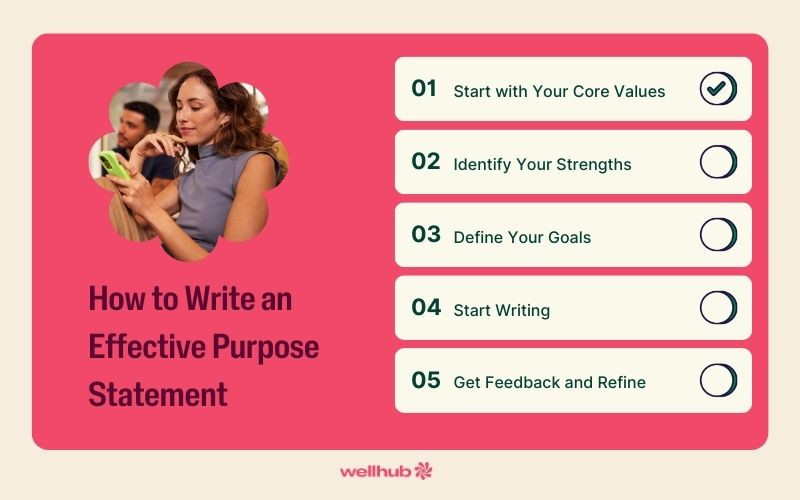How to Write a Powerful Purpose Statement for Your Business
Last Updated Apr 3, 2025

A purpose statement is far more than just another branding trend. It’s a call to action, a way to define your goals, and a staple of your company's identity. Just one sentence can help you successfully scale your organization — as long as it’s well-written.
Fortunately, crafting a powerful purpose statement isn’t complicated. It just takes a little creativity and communication. If your business has clear goals and a thriving organizational structure, writing a great purpose statement should be no problem.
Here’s an in-depth look at the importance of purpose statements and how you can write one to drive your business’s success.
What Is a Purpose Statement?
A purpose statement is a straightforward description of a company’s focus or position. It directly addresses your target audience and should explain to them:
- Why your business exists
- How you will serve them
- How representatives of your business should relate to them
- What kind of impact your business will have
Most purpose statements are one or two sentences long. It should be informative yet succinct, wrapping up your business’s intentions into a tidy declaration anyone will understand.
Like team building and other HR initiatives, a purpose statement can help shape a positive work culture. It also serves as a crucial branding tool that will make your business more appealing to your target audience. However, it’s important to understand that a purpose statement is not the same thing as:
- A mission statement: Your mission statement should outline your business’s overall goals, rather than focusing on the benefits you bring to your customers.
- A value statement: This is a statement of your business’s ethics and core beliefs, such as workplace diversity or corporate social responsibility.
While all three statements are important elements of your brand, the purpose statement is the most direct explanation of what your business does and how it will help your customers.
Real-World Examples of Purpose Statements
Wondering what a great purpose statement looks like in action? Here are a few purpose statement examples from major organizations to get you inspired.
- Bank of America: “A company united in our purpose to help make financial lives better through the power of every connection.”
- Ralph Lauren: “Our Purpose at Ralph Lauren is to inspire the dream of a better life through authenticity and timeless style.”
- Campbell’s Soup: “Campbell’s was founded as a purpose-driven company and, for over 150 years, the essence of our purpose has not changed: to make food that is delicious, affordable, and prepared with care — food that people love.”
- Intel: “We create world-changing technology that improves the life of every person on the planet.”
As you can see, these statements are all uniquely worded yet get a clear point across. They tell you exactly what the company does and why it matters to customers.
The Power of Purpose
Words have a powerful impact. A purpose statement doesn't just inform your customers—it should shape your company from the inside out. A strong, clear statement guides your internal culture, fostering efficient workflows and effective communication.
Here are some of the most notable benefits of a well-written purpose statement:
Strategic Decision-Making
Decision making has become more complicated in the modern era. Around 65% of business decisions are more complex today than they were in 2019, according to a Gertner survey. A clear purpose statement ensures that everyone on your team — stakeholders and employees alike — is on the same page when it comes to decisions that move your business forward.
Talent Acquisition
A great purpose statement helps HR teams attract and retain top talent. It shows new applicants that your business has a clear, unified vision, which demonstrates strong leadership and a stable work environment.
Employee Engagement
An organization’s purpose is one factor that drives better employee engagement, according to data from McKinsey. Employees are more likely to feel engaged and motivated when they understand how their work impacts the business’s overall purpose.
Organizational Culture
There are tons of changes HR leaders can make to improve company culture, including offering great parental leave or a competitive benefits package. A strong purpose statement also helps support a positive culture by unifying team members under a common goal, and guiding what changes you as a department prioritize.
Innovation and Growth
An extended benefit of building your dream team and fostering better employee engagement is increased innovation. Motivated, talented team members who clearly understand your business’s purpose will come up with new ideas that drive growth.
Brand Reputation
Although a purpose statement is more than just a branding tool, its benefits for your brand reputation can’t be overstated. A specific purpose is a key element of a strong brand, as reported by the Small Business Development Center at the University of Rhode Island. Your purpose statement helps your brand stand out from the crowd, making it more appealing to your unique customer base.
Key Elements of a Compelling Purpose Statement
It’s clear that a great purpose statement has tons of benefits for your business. But what exactly makes a statement great?
Make sure to nail these few key elements when creating a compelling, effective purpose statement:
- Clarity and conciseness: Your purpose statement shouldn’t read like a poem. Avoid flowery language — keep it simple, direct, and clear.
- Inspiration and aspiration: A great purpose statement is written to inspire innovation and outline goals your employees should aspire to, similar to an HR vision statement.
- Relevance and authenticity: You want your purpose statement to stand out. Make sure it’s unique to your brand and relevant to your target audience. You should speak to your audience directly rather than casting a wide net.
- Alignment with core values: Your purpose statement should align with your organizational values without explicitly stating them. For example, if workplace diversity is one of your core values, words like “inclusive” or “progressive” reflect that value in your purpose statement.
- Memorable and impactful: Like a great slogan, your purpose statement should stick with the reader. It will be one of the first things that comes to mind when they think of your brand.
That might seem like a lot to fit into a single sentence, but each of these elements blends together smoothly in the best purpose statements. It doesn’t have to be long and wordy to be compelling.
A Step-by-Step Guide to Crafting Your Purpose Statement

Like the best corporate wellness initiatives, a great purpose statement is an investment in your business’s long-term success. Fortunately, this investment comes with very little overhead. All you need is time, input from your team, and a hefty dose of creativity to maximize your ROI.
Follow this step-by-step guide to write a purpose statement that unifies your teams, pushing you forward.
Step 1: Start with Your Core Values
Start by outlining your company’s core values and beliefs. These might include:
- Accountability
- Teamwork
- Social responsibility
- Diversity, equity, and inclusion
- Creativity
- Environmental responsibility
Your purpose statement should align with these values and demonstrate how your company harnesses them. For example, Ralph Lauren’s purpose to “…inspire the dream of a better life…” may be based on values of innovation and inclusion.
Step 2: Identify Your Strengths
What does your business offer your target audience that other companies don’t offer? Identify your key strengths and contributions to your industry. For example, if your business invests in wellness programs, one of your strengths is an active and engaged team, which benefits customers who appreciate great communication and friendly communication.
Step 3: Define Your Goals
Next, outline your goals. Not in terms of business growth, but in terms of impacts. How does your business aspire to make a difference in your industry?
Intel’s statement is a great example of how goals drive a company’s purpose. The use of “world-changing” shows the company’s aspirations to reshape the tech industry in a way that impacts the entire world.
Step 4: Start Writing
Now it’s time to bring all those elements together into your first draft. This does not have to be your final purpose statement. It’s okay if the first draft is too long, awkwardly worded, or simply not quite right. Just get the words down on paper to get your creative juices flowing.
Step 5: Get Feedback and Refine Your Purpose Statement
Your purpose statement shouldn’t be written by one person, or even one team. It’s important to get feedback from multiple stakeholders and employees. This will help bring a variety of perspectives to your purpose statement, ensuring it’s reflective of the entire company’s values.
One way to refine that first draft is to ask a handful of employees to write their own purpose statements. Compare those samples to your draft and look for any creative elements you might have missed. Don’t hesitate to bring in a content writer or marketing professional to make sure your final draft truly shines.
How to Bring Your Purpose Statement to Life
Crafting a powerful purpose statement is only half the job. To maximize the impacts of your purpose statement, you have to make sure it’s effectively incorporated into your company’s culture.
What does that look like in practice? Here are a few strategies to take that purpose statement from words to action.
Help Team Leaders Model Your Purpose
A unified, productive team starts with visionary leadership. Leaders in your business should embody your purpose statement and model positive action for other employees.
That means your purpose statement should be embedded into leadership training, whether you’re hiring team leaders or promoting from within your business. Make sure new leaders understand your purpose statement and know how it should shape their actions. For example, if your business’s purpose is to create innovative solutions for your customers, your leaders should model creative problem-solving and encourage team members to embrace new ideas.
Engage Employees at All Levels
Incorporating the purpose statement into leadership styles is just one piece of the puzzle. You’ll also want to engage employees at all levels of your business, embedding your business’s goals and values into everyday workflows.
One great way to do this is with fun team-building activities. Use group games and strategies to demonstrate how each employee contributes to a common goal.
Let Your Purpose Statement Guide Strategies and Decision-Making
Think of your purpose statement as the lighthouse that guides all your business’s initiatives to shore. In other words, every decision made by company leaders should be in line with your overall purpose.
Consider the example of Campbell’s purpose statement: “…to make food that is delicious, affordable, and prepared with care.” If your business has a similar statement, you should focus on strategies that improve product quality and affordability. Your branding initiatives should embrace wholesome, friendly messaging to reflect that “prepared with care” intention.
Track Your Progress and Reassess
As your business scales, it’s possible for your goals, vision, and purpose to change. Conduct routine assessments to make sure your purpose statement is still effective. Several ways to gauge how well your statement resonates over time include:
- Employee Engagement & Alignment
- Employee Surveys: Conduct regular surveys to gauge how connected employees feel to the company’s purpose. You can ask questions like:
- “Do you feel our purpose aligns with your personal values?”
- “How motivated are you by the company’s purpose?”
- Pulse Check Metrics: Use pulse surveys (e.g., monthly or quarterly) to track changes in engagement levels over time. If engagement rises following purpose-driven initiatives, that’s a good sign it’s resonating.
- Purpose Understanding Scores: Ask employees to describe the company’s purpose in their own words. The more aligned their responses, the better the purpose is embedded in your culture.
- Organizational Culture & Behavior
- Purpose-driven KPIs: Track specific behaviors tied to your purpose (e.g., volunteerism, internal collaboration, or innovation rates) to see how often employees act in alignment with these values.
- Decision-making Analysis: Evaluate whether leadership and team decisions reflect the purpose. If your purpose prioritizes sustainability, for example, are leaders making choices that support environmental goals?
- Customer Perception & Loyalty
- Net Promoter Score (NPS): Segment your NPS results to see if customers who are more aware of your purpose are more likely to recommend your company.
- Customer Feedback: Use feedback forms, social media monitoring, and focus groups to understand if customers can articulate your purpose and if it influences their buying decisions.
- Brand Sentiment Analysis: Track online mentions to gauge if discussions around your brand reflect the values outlined in your purpose statement.
- Business Performance Metrics
- Turnover Rates: A clear purpose can reduce employee turnover by creating a strong sense of belonging. Track turnover over time, especially after introducing or refining your purpose statement.
- Performance and Productivity: Use performance evaluations and productivity metrics to see if teams that align strongly with your purpose outperform those that don’t.
- Talent Attraction Metrics: Monitor application and acceptance rates for roles within your organization. Are purpose-driven initiatives leading to more candidates who align with your values?
- Internal Communication Effectiveness
- Engagement with Purpose-related Content: Track the engagement rates of internal communications focused on your purpose (e.g., intranet posts, newsletters). Higher open and click rates suggest stronger alignment.
- Cross-Department Collaboration: If your purpose includes fostering collaboration, monitor collaboration tools (e.g., Slack, project management software) to see if teams are increasingly working together.
By using a combination of these metrics, you’ll be able to see if your purpose statement is more than just words on paper—whether it’s driving real action and making a measurable impact on your business.
Maximize the Power of Your Purpose Statement with Employee Wellness
A purpose statement is so much more than just a statement. It’s a guiding set of principles, a team development tool, and a crucial investment in your business. When writing a purpose statement, be sure to take your time and carefully consider your business’s goals and values. Incorporate the final statement into every aspect of your organization, from training to team bonding exercises.
Want to maximize the power of a great purpose statement? Employee wellbeing programs give your staff the resources to feel engaged and motivated. This give your team the energy they need turn your business’s purpose statement from a vision into reality.
Speak with a Wellhub wellbeing specialist today to learn more about how wellbeing programs can help your business achieve its purpose!

Company healthcare costs drop by up to 35% with Wellhub*
See how we can help you reduce your healthcare spending.
[*] Based on proprietary research comparing healthcare costs of active Wellhub users to non-users.
You May Also Like
- Mission vs. Vision Statements: What’s the Difference?
- 16 Organizational Values Examples From Top Brands That Will Inspire Your Own
- Create a Thriving Organizational Culture
References:
- Gartner. (n.d.) Effective decision making must be connected, contextual and continuous. https://www.gartner.com/smarterwithgartner/how-to-make-better-business-decisions
- Emmett, J., Komm, A., Moritz, S., & Schultz, F. (2021, September 30). This time it’s personal: Shaping the “new possible” through employee experience. McKinsey & Company. https://www.mckinsey.com/capabilities/people-and-organizational-performance/our-insights/this-time-its-personal-shaping-the-new-possible-through-employee-experience
- Rhode Island Small Business Development Center. (2018, May 2) Why branding is key to success: 7 elements of a strong brand. . https://web.uri.edu/risbdc/why-branding-is-key-to-success-7-elements-of-a-strong-brand/
- Bank of America. (n.d.). About Bank of America: Our strategy, Mission & Vision. https://about.bankofamerica.com/en/our-company
- Ralph Lauren. (n.d.) Next great chapter: Accelerate. Strategy. (n.d.). https://corporate.ralphlauren.com/strategy
- Campbell Soup Company. (2024, July 8). Purpose, values, and culture. https://www.campbellsoupcompany.com/about-us/purpose-values-culture/
- Intel. (n.d.). General information about Intel Corporation: What are Intel’s... https://www.intel.com/content/www/us/en/support/articles/000015119/programs.html
Category
Share

The Wellhub Editorial Team empowers HR leaders to support worker wellbeing. Our original research, trend analyses, and helpful how-tos provide the tools they need to improve workforce wellness in today's fast-shifting professional landscape.
Subscribe
Our weekly newsletter is your source of education and inspiration to help you create a corporate wellness program that actually matters.
Subscribe
Our weekly newsletter is your source of education and inspiration to help you create a corporate wellness program that actually matters.
You May Also Like

Vision Statement: Examples and Tips For Writing One | Wellhub
Leverage these tips to write a powerful vision statement that shapes your company's goals and culture, creating a lasting business impact.

Business Management: Skills, Benefits, and Strategies
Use these tips to improve business management skills, enhance employee engagement, and build a stronger foundation for organizational success.

Profit and Loss Statement: Key Elements, Analysis Tips | Wellhub
The P&L is a financial snapshot of a business's income and expenses over time. Unlock the key to strategic decision-making.